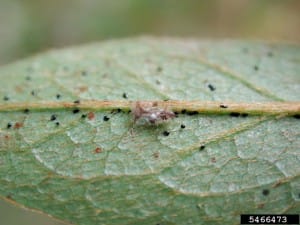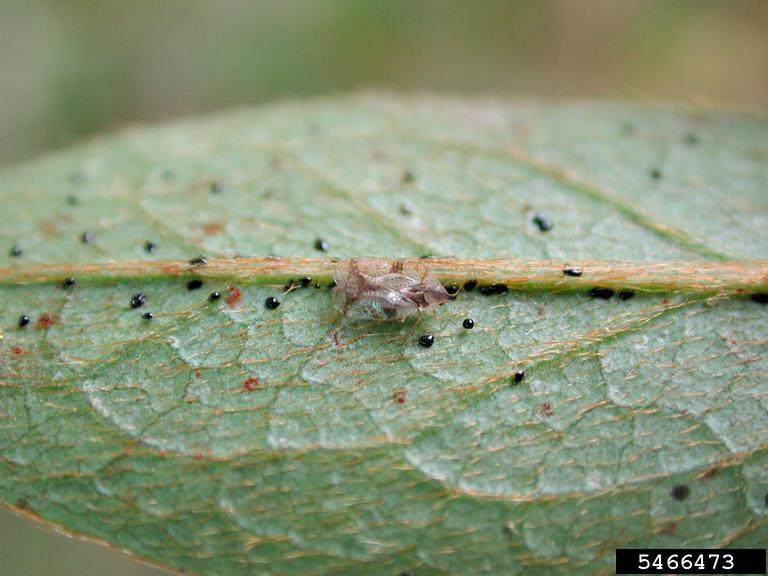Source – Will Hudson and Kris Braman, UGA Extension Entomologists

Azalea lacebugs overwinter as eggs and hatch in the spring. Early spring is a good time to control them before they become too numerous.
Azalea lace bug attacks azaleas and some rhododendrons. Azalea lace bugs mainly feed on the undersides of the leaves, leaving the top of the leaf with white to yellow stippling or flecking. Heavy lace bug feeding on azalea can reduce plant vigor and flowering and affects the overall look of the plant.
Adult azalea lace bugs are 1/8 inch long. The transparent wings are held flat on the back. Their wings are lacy with two grayish-brown cross-bands connected in the middle. Nymphs begin life clear but quickly turn black and spiny. The flask-shaped eggs are partially embedded in leaf tissue, usually on the bottom of the leaf, and often are covered with a black tar-like secretion.
Look for the first signs of damage on plants in full sun or in protected areas beginning in March and continuing throughout the summer. Lace bugs overwinter as eggs. There are four generations a year. Lace bug adults and nymphs live and feed on the underside of leaves. Look for white stippling on older leaves. Look under leaves to find lace bug life stages and black fecal spots. On azaleas with a lot of damage, the top of the leaf can become grey or silvery.
Azaleas can withstand a lot of lace bug injury without much reduction in growth or bloom. The damage however on the leaves is unsightly. Control is generally recommended for the spring when insects are few in numbers. Treating early also protects the new leaves from damage from these insects. Once a leaf is damaged, the injury will be visible until the leaf falls off the plant.
Time spring insecticide applications for the presence of the first generation nymphs, usually with the early warm weather in late February in south Georgia through March and April in central and north Georgia.
Late summer insecticide applications are also helpful. Lacebugs overwinter as eggs and managing adults now reduces the number of eggs on plants and the number of lacebugs you will see next spring. Once lacebugs are in the egg stage, insecticides will not effectively manage them.
Cultural controls for azalea lace bugs
- Plant azaleas only in partial shade. Too much sun stresses the plant and can make lace bug injury worse.
- Keep plants healthy with proper planting, fertilizing and watering.
- One of the best things you can do is scout azaleas (particularly early in the season) to identify and control infestations before numbers increase and leaf damage is severe.
Chemical Controls
Contact insecticides include the pyrethroids (bifenthrin, cyfluthrin, cypermethrin, permethrin, etc.) and carbaryl (Sevin and others) as well as other insecticides.
- The biggest concern with contact insecticides is getting full coverage. The chemical must be applied to the underside of the leaves. This is difficult with larger, fuller plants.
- You may need to make more than one application for full control. Check plants three to four weeks after the first application to see if they need another treatment. Knocking the branches over a white piece of paper should dislodge the lace bugs and make them easier to see.
Systemic insecticides
- Some systemic insecticides may be used as soil applications (liquid drenches and granular treatments) as well as sprays. Soil applied insecticides enter through the root system and then travel into the leaves.
- Foliar sprays of systemic insecticides tend to work more quickly than soil application but soil applications give a longer residual control – up to several months.
- Even though some soil applied systemic insecticides may take two weeks or longer to become active in the leaves of large plants, this is not a problem if plants are small or if application is made early enough in the season to provide protection for the first flush of new leaves.
- Read and follow all label directions since systemic insecticides differ in the way they work in the plant.
For more information:
For pest management information see the Pest Management Handbook (Follow all label recommendations when using any pesticide)
Contact your local Extension Agent at (800) ASK-UGA1 or locate your local Extension Office at http://www.caes.uga.edu/extension/statewide.cfm

I really appreciate the insight here in this post and confident it’s going to be helpful to me and many others. Thanks for your post.